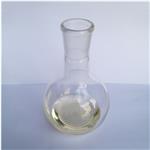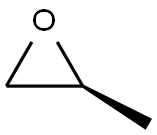(S)-(-)-Propylene oxide-Application
(S)-(-)-Propylene oxide is widely utilized in the manufacture of polyether polyols and propylene glycol, which is used in making the polyurethane plastics. (S)-(-)-Propylene oxide finds an application as a fumigant for the sterilization of packaged foods and plastic medical instruments. Combine with ethanol, (S)-(-)-Propylene oxide used to make biological samples for electron microscopy. (S)-(-)-Propylene oxide is also used in model aircraft and surface vehicles as a glow fuel[1,2].

Epoxide carboxylase from the bacterium Xanthobacter strain Py2 is a multicomponent enzyme system which catalyzes the pyridine nucleotide-dependent carboxylation of aliphatic epoxides to β-ketoacids as illustrated by the reaction epoxypropane + CO2 + NADPH + NAD+ → acetoacetate + H+ + NADP+ + NADH. The combination of four distinct proteins, designated components I−IV, are required for the reconstitution of epoxide carboxylase activity with racemic mixtures of short-chain (C3−C5) terminal epoxyalkanes. In this work, components III and IV of the epoxide carboxylase system are shown to confer specificity for epoxyalkane enantiomers. Components I−III supported the carboxylation of (R)-epoxypropane, while components I, II, and IV supported the carboxylation of (S)-(-)-Propylene oxide. At fixed concentrations of components I and II, the rates of (R)- and (S)-(-)-Propylene oxide carboxylation saturated with increasing concentrations of component III or IV to give identical maximal rates for the two epoxide substrates.
(S)-Epoxypropane was an inactivator of (R)-epoxypropane carboxylation by components I− III, while (R)-epoxypropane was an inactivator of (S)-(-)-Propylene oxide carboxylation by components I, II, and IV. These inactivating effects were fully reversed upon the addition of the correct complementing dehydrogenase component. Amino acid sequence analysis of components III and IV demonstrates that they belong to the short-chain dehydrogenase/reductase (SDR) family of enzymes. Both components contain highly conserved residues within the coenzyme binding fold and catalytic regions found in SDR enzymes. Components III and IV are proposed to catalyze the NAD+-dependent abstraction of a hydride from a chiral secondary alcohol-like intermediate bound to the active site component of the enzyme system to form the corresponding β-ketone intermediate. A multicomponent epoxide carboxylase system was purified to homogeneity from Nocardia corallina B276, a bacterium phylogenetically unrelated to Xanthobacter Py2, and found to consist of four proteins with functions identical to those of the Xanthobacter Py2 system. The stereoselective dehydrogenases of the Xanthobacter epoxide carboxylase system were able to substitute for the corresponding components of the N. corallina system when using (R)- and (S)-(-)-Propylene oxide as substrates, and vice versa. These results provide the first demonstration of the involvement of stereospecific dehydrogenases in aliphatic epoxide metabolism and provide new insights into microbial strategies for the utilization of chiral organic molecules[3].
References
[1]Kalyoncu, S.; Düzenli, D.; Onal, I.; Seubsai, A.; Noon, D.; Senkan, S. Direct epoxidation of propylene to propylene oxide on various catalytic systems: A combinatorial micro-reactor study. Catal. Commun. 2015, 61, 16-20.
[2]Zee, N. J. V.; Coates, G. W. Alternating Copolymerization of Propylene Oxide with Biorenewable Terpene-Based Cyclic Anhydrides: A Sustainable Route to Aliphatic Polyesters with High Glass Transition Temperatures. Angew. Chem. 2015, 127 (9), 2703-2706.
[3]Allen J R , Ensign S A . Two short-chain dehydrogenases confer stereoselectivity for enantiomers of epoxypropane in the multiprotein epoxide carboxylating systems of Xanthobacter strain Py2 and Nocardia corallina B276[J]. Biochemistry, 1999, 38(1):247-56.
You may like
See also
Lastest Price from (S)-(-)-Propylene oxide manufacturers

US $0.00-0.00/KG2025-04-19
- CAS:
- 16088-62-3
- Min. Order:
- 1KG
- Purity:
- 99%
- Supply Ability:
- 20000

US $30.00-10.00/KG2025-04-15
- CAS:
- 16088-62-3
- Min. Order:
- 50KG
- Purity:
- 99%
- Supply Ability:
- 500000kg


